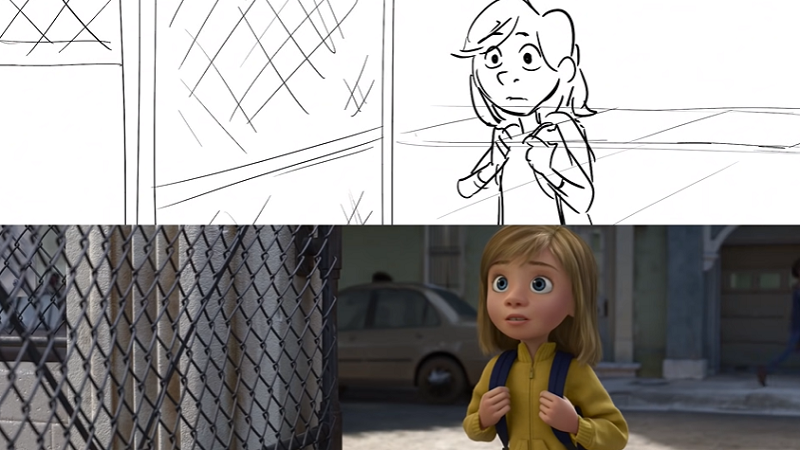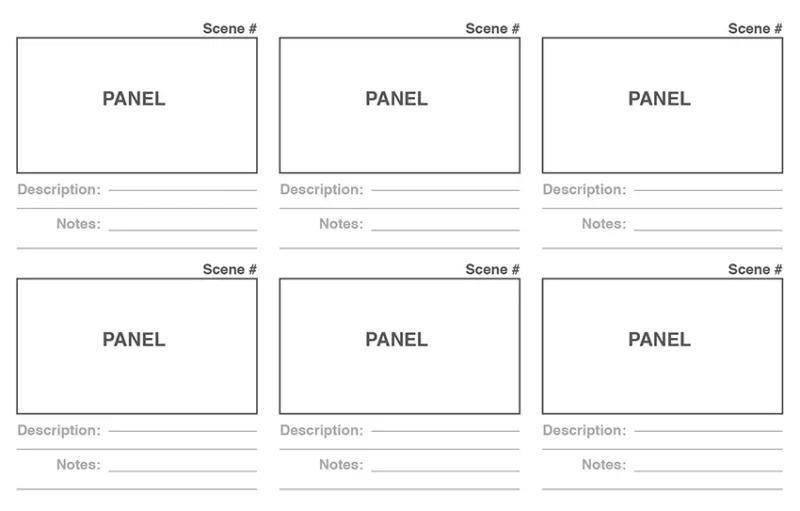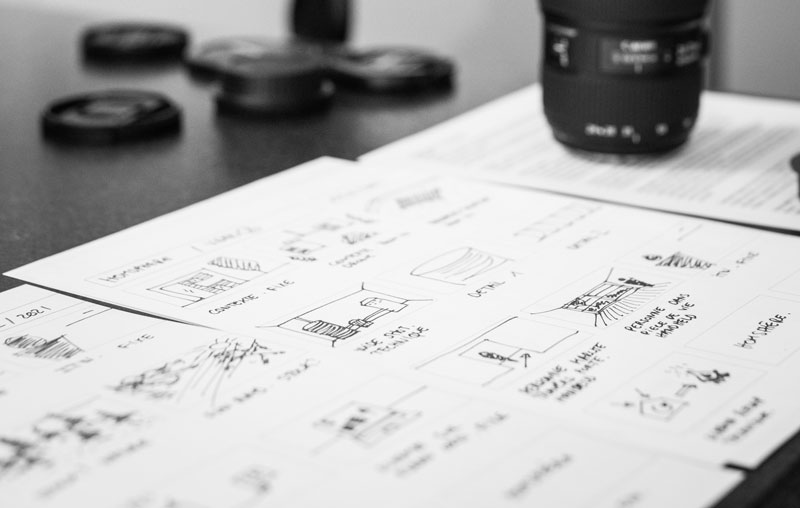Storyboards are generally used in different industries, such as film, gaming, advertising, and TV. It helps to create an outline of the project’s creative vision to make sure everyone involved in the project is on the same page.
An efficient visual plan is essential in large projects such as animation or filmmaking, where errors or lack of planning can lead to time delays and financial setbacks.
In this article, we will discuss the process of animation storyboarding as well as the different methods used to do it. This article will conclude with some handy tools and helpful tips.

A Brief History of Storyboarding
The idea behind storyboarding goes back to the early days of cinema. The filmmakers would use this tool to plan how they would shoot scenes. The storyboarding method became more common during the 1930s and 40s because Disney started to develop storyboarding software. Since that time, storyboarding has become a vital part of the filmmaking process and has become the standard for many different creative endeavors, such as video game making, advertising, and animation.
An Example of Animation Storyboarding
Storyboarding can be seen in the early stages of animation production. Directors, in cooperation with writers and artists, would create outlines of the story and draw and visualize every scene of the animation. This allows the creative crew to experiment with different approaches to filmmaking, such as camera angles, pacing, and show composition. In fact, the storyboard acts as a blueprint for all the teams involved in the production, such as set design, lighting, sound, and logistics, so they can plan their operations. Essentially, directors use a storyboard to plan every single stage of their production, from story writing and character design to the shape language of the film.
Here is an example of Pixune’s work, a 3D animation studio. Based on the script, the designer worked on ideation and visualization while keeping the desired atmosphere and style in mind. It highlights all the necessary details, and you can see that the storyboard artist painstakingly planned out every aspect of this sequence, and like all best storyboards, it pinpoints the key shots.
Check out the trailer for the 3D Animated Commercial, Dragon Shield.
Why Do You Need a Storyboard?
A storyboard is a tool for organizing, planning, and executing a creative process such as animation or filmmaking. It can help to identify potential problems or roadblocks in the production process. By using a storyboard, many of these problems can be detected and resolved early in production. As an example, it can reduce video game costs during the pre-production stage. A storyboard is a roadmap for the project, which helps to guarantee success. In some fields, such as animation, it becomes even more important since it becomes a full blueprint for the entire animation production pipeline because it can be used to provide cohesion and consistency for the animation and help to plan the exact timing of each shot. By using storyboards, animation modelers can quickly and consistently make changes to the story before they even start shooting.
Here are six benefits of storyboarding:
1. Visualization
It aids in the visualization of the story or project, making it easier to comprehend and communicate with others.
2. Planning and organization
Storyboarding is a structured method of planning a project and organizing ideas.
3. Increased creativity
Storyboarding allows creators to experiment with different ideas and approaches before committing to a final version.
4. Improved collaboration
Storyboarding can help team members communicate and collaborate more effectively, improving the overall quality of the project.
5. Time-saving
Creators can identify potential problems early in the production process by creating a storyboard, saving time and resources. The production team can efficiently move forward when they understand what needs to be done and delivered.
6. Clarity of purpose
Storyboarding clarifies a project’s goals and objectives, ensuring that everyone involved is working toward the same goal.
How to Create a Great Animation Storyboard in 7 Steps
The following are some of the general steps for creating a storyboard which can be a great help for creative processes such as animation and filmmaking.
- Define a narrative: Start with a synopsis of the story. It will give a clear and concise idea of what the storyboard should include.
- Mark the crucial moments: Find important & key moments for the story and decide where you want to emphasize. These can be the opening, climax, or closing scenes.
- Sketch the frames: Create rough drawings (black & white or colored sketches) for key moments in the story. Make sure it conveys the mood of the moment. You can read more about color theory in character design in our blog.
- Label everything: Each frame should be clearly labeled in order to explain what’s going on at that moment. Here’s a template that can be used.

- Add timing and camera angles: Each frame should include the timing and the specific angle. This can greatly help in visual representation and pacing.
- Revise: Constantly go over everything and make changes as necessary. Changes such as removing frames, changing camera angles, etc.
- Review: Once everything is set, make a final version of the storyboard.
Also, Here is a video with some techniques for storyboarding a sequence.
Popular Methods for Designing an Animation Storyboard
There are several methods for creating a storyboard, each with its own strengths and weaknesses. Below we have listed some of the popular methods for storyboarding:
Traditional Visualization
This method entails sketching and drawing the scenes of a story in sequence on individual sheets of paper. The sketches, which can be simple or elaborate, aid in visualizing the story before filming begins. This method works well for animators and filmmakers who are visually oriented and prefer to work with pen and paper.

Digital Visualization
This method employs software, such as Storyboard Pro or Adobe Photoshop, to create a storyboard. The advantage of using digital tools is that they allow for easy collaboration, revision, and sharing with others. Digital storyboarding also enables animators to incorporate sound and special effects into their storyboards, making the process more immersive.
Scratchboard Storyboarding
This method is a variation of traditional storyboarding that involves drawing directly onto a coated board with a stylus, creating lines that resemble those of a pencil or pen. Scratchboard storyboarding allows for greater details and precision in the drawings, making it ideal for storyboarding complex sequences.
Photomontage Storyboarding
This method creates a visual representation of the story by using photographs, either taken specifically for the storyboard or sourced from elsewhere. Photomontage storyboarding is effective for projects that require a more realistic representation of the final product and can be useful for quickly visualizing an idea.
3D Method
This method involves creating a 3D representation of the story using computer graphics and animation software. 3D storyboarding is especially useful for projects that require extensive special effects or complex camera movements because it allows the storyteller to better visualize the final product.
Depending on the requirements of your project, your preferences, and your creative approach, you will select a certain storyboarding technique. Whether you choose traditional sketching, digital tools, photomontage, or 3D storyboarding, the key is to experiment and find the method that works best for you.
Best Animation Storyboarding Software Tools
All you need to create storyboards is a pen, paper, and a good idea. We actually recommend that you start with pen and paper and leave the tools for when you’re comfortable with the basics.
However, with everything else in life, modern tech can ease things up and make them shinier! Here are some of the best tools around to help you create stunning storyboards.
Storyboard That
Create colored storybooks using a huge library of premade objects, characters, backgrounds, and more. Storyboard That is one of the oldest, most trusted storyboard tools around. Its user-friendly interface is ideal for first-timers. Especially useful for animation storyboards since its library is styled that way.
Boords
Boords offer a deeply satisfying online storyboard creation platform tailored for those working in a team. Its collaborative nature facilitates smooth communication and task management between multiple members of a team.
Storyboarder
Storyboarder is the continuation of a much older, open-source tool called “Storyboard Fountain.” It was already a great tool before getting bought by a tech company. It’s now better than ever, and to be honest, it is our favorite storyboarding tool at Pixune. You only need to try it for 5 minutes to find out why!
CeltX
If you’re looking for a professional tool used by Hollywood people and veterans, look no further. In addition to storyboards, you can create and mix all kinds of screenplays, visual novels, and even video game scripts.
CeltX is not as easy to use as the Storyboard That or Boords, but with a little bit of time and effort, it will become a great addition to your resume.
Helpful Storyboarding Tips
We talked about the systematic process of creating an “acceptable” storyboard, but what makes for a “great” storyboard? What are some of the most common pitfalls? How can we improve the efficiency of our storyboards? Follow these simple tips to make your storyboards look professional from the very beginning.
- You should have a clear idea of the story you want to tell before you begin.
- Focus on keeping the story simple.
- Visuals should be clear and concise.
- Organize the flow of events and transitions.
- Guide the audience’s attention with visual cues.
- To clarify your intent, add annotations or notes.
- Try different angles and framings.
- Keep your pacing and rhythm in mind.
- Make revisions to your storyboard based on feedback from others.
- Make changes as needed and be flexible.

We at Pixune Can Help You Develop a Storyboard for Your Next Animation or Game
With Pixune Studio, you can count on excellent quality for your storyboarding projects. We are happy to provide you with a free quote, and we look forward to talking about your project. Visit our 3D Animation Services page and register your request.
Final Words
A storyboard is a visual representation of an animation, film, comic strip, or video game, laid out in sequence.
It typically includes illustrations to describe an action, the characters, and the overall mood of each scene.
The purpose of a storyboard is to provide a clear overview of a story and help animators, filmmakers, video game developers, and comic book artists plan and organize the creative process before actual production begins.
The following are the steps for creating a storyboard:
- Describe the story in a synopsis
- Make sure you mark the crucial moments
- Create the frames
- Be sure to label everything, including timing and camera angles
- Examine everything and make changes as needed
- Review and finalize
FAQs
How do you decide shot composition & perspective effectively?
Use rule of thirds, foreground / background layering, vary angles (low, high, Dutch) to support mood & story.
What’s the 180-Degree Rule and why is it important in storyboarding?
It ensures spatial continuity: you keep camera on one side of an imaginary line between characters to avoid confusing viewers.
How to plan camera movement (zoom, pan, tracking) in storyboards?
Show motion via arrows/notes, mark start & end positions; indicate speed & path to convey flow.
How do you balance pacing & timing between storyboard and final animatic?
Estimate duration per panel; fewer panels for slow scenes, more for fast/action; revise with feedback in the animatic stage.
How much detail to include in storyboard vs later stages?
Enough to show framing, main poses & motion; detailed shading, textures saved for later. Rough sketching often enough.
What are silhouette clarity & arcs, and why do they matter?
Silhouettes ensure actions readable without internal detail. Arcs make movement natural, visually engaging.
How do you maintain visual continuity across frames?
Keep character size, direction, lighting & backgrounds consistent; adhere to spatial rules like 180°; use reference sheets.
How to show subtle emotion & expression in storyboards?
Use exaggerated facial expressions & body language; hold key poses; close-ups for emotional moments.
How to storyboard complex action sequences?
Break into key poses: anticipation, peak action, release; plan camera cuts & movement carefully; use overlapping panels.
How do you incorporate sound, splitting dialogue, Foley & music cues?
Add notes under panels, mark key cues; use animatic to sync. Often dialogue & important sounds included early.
What’s an animatic or leica reel and when should I use it?
A storyboard turned into timed sequence with audio (voice, effects) to test pacing before full animation.
How many storyboard panels per script page are typical?
Varies by complexity & style. Many boards do 1+ panels per shot or major action change; action heavy pages have many panels.
Should storyboard artists know cinematography & editing basics?
Yes. Shot size, angle, cut, transition, timing all derive from film/ editing language; helps better planning.
How to use thumbnails & roughs effectively in early storyboarding?
Quick small sketches to test flow, composition & shot sequence; iterate before committing to detailed panels.









